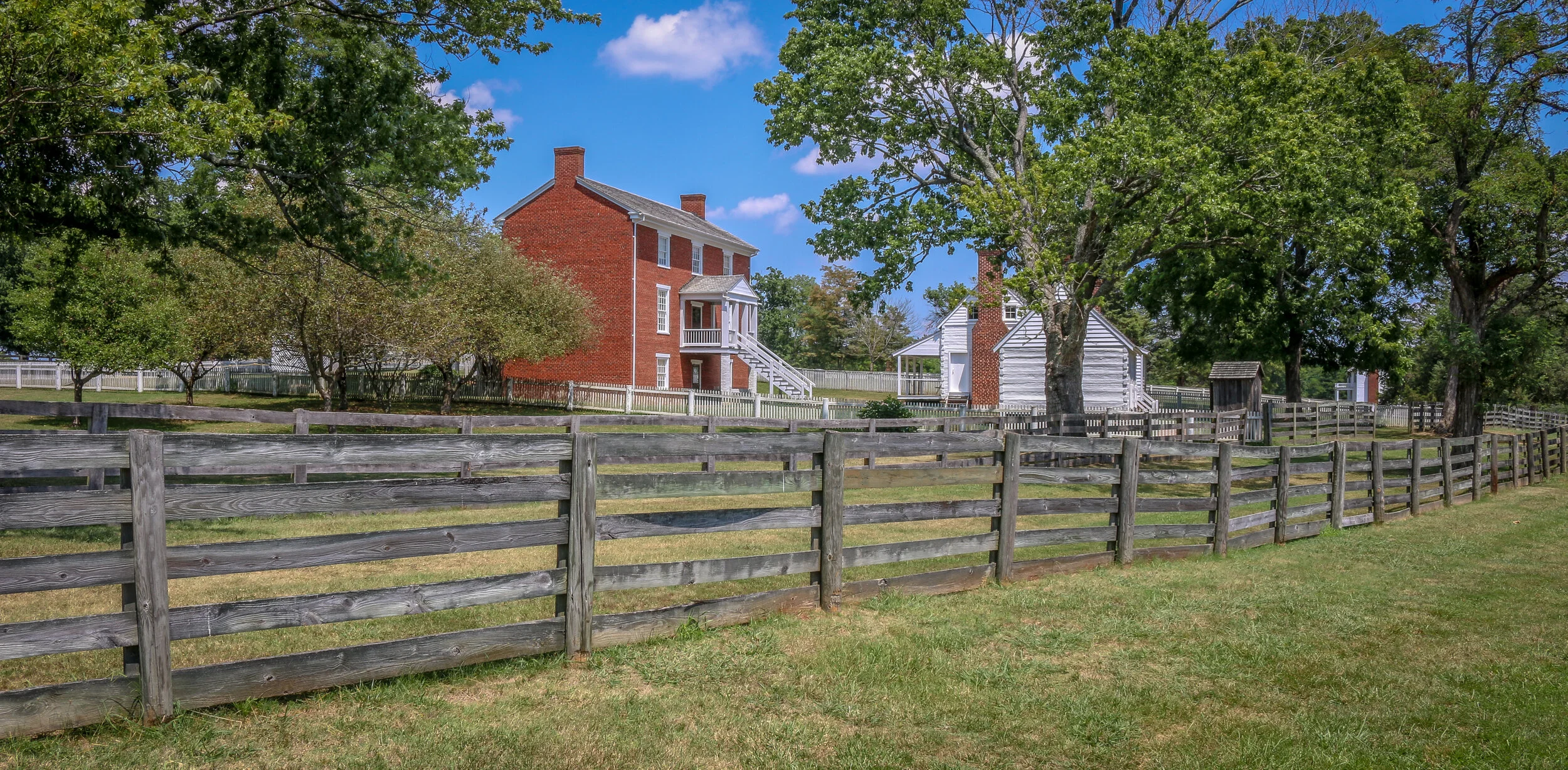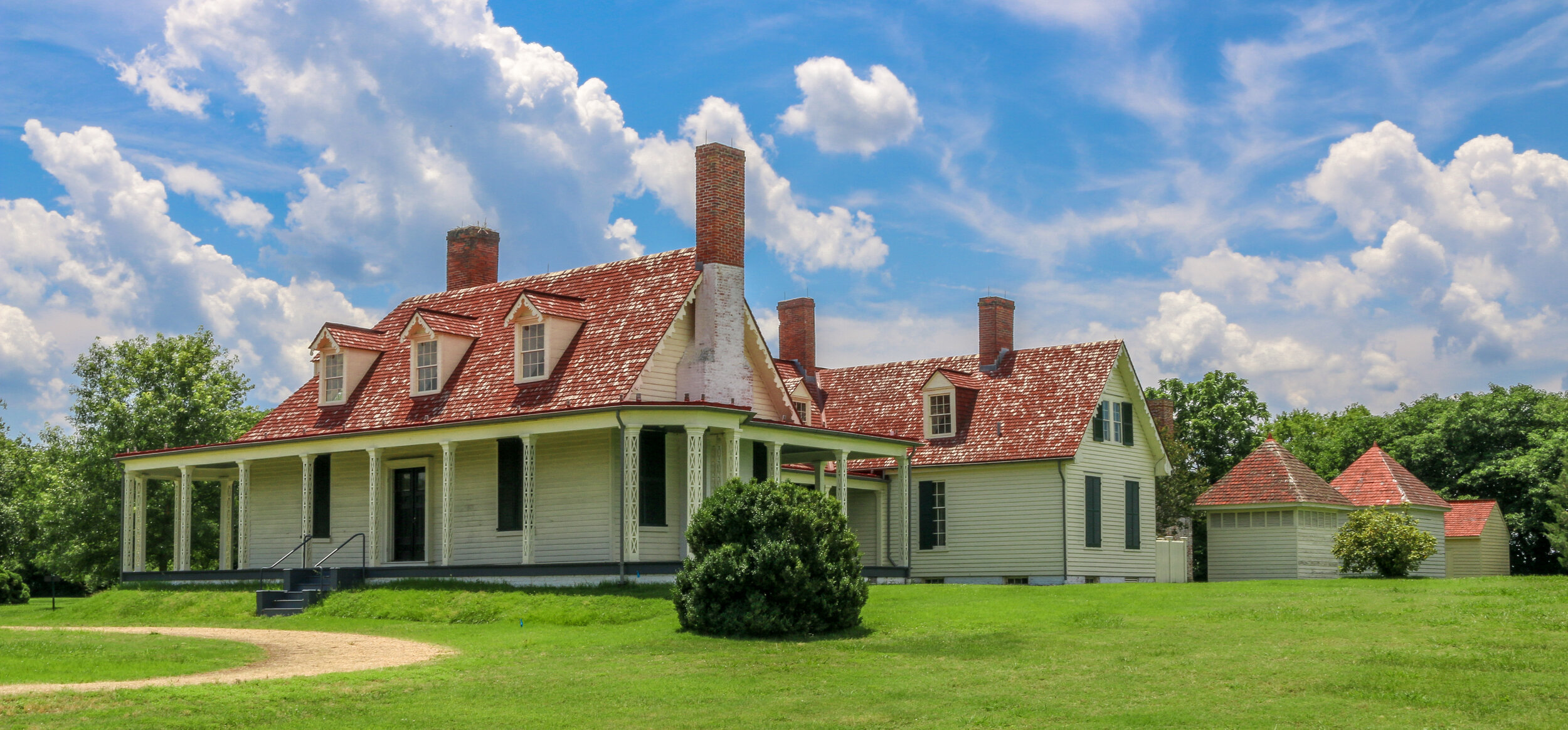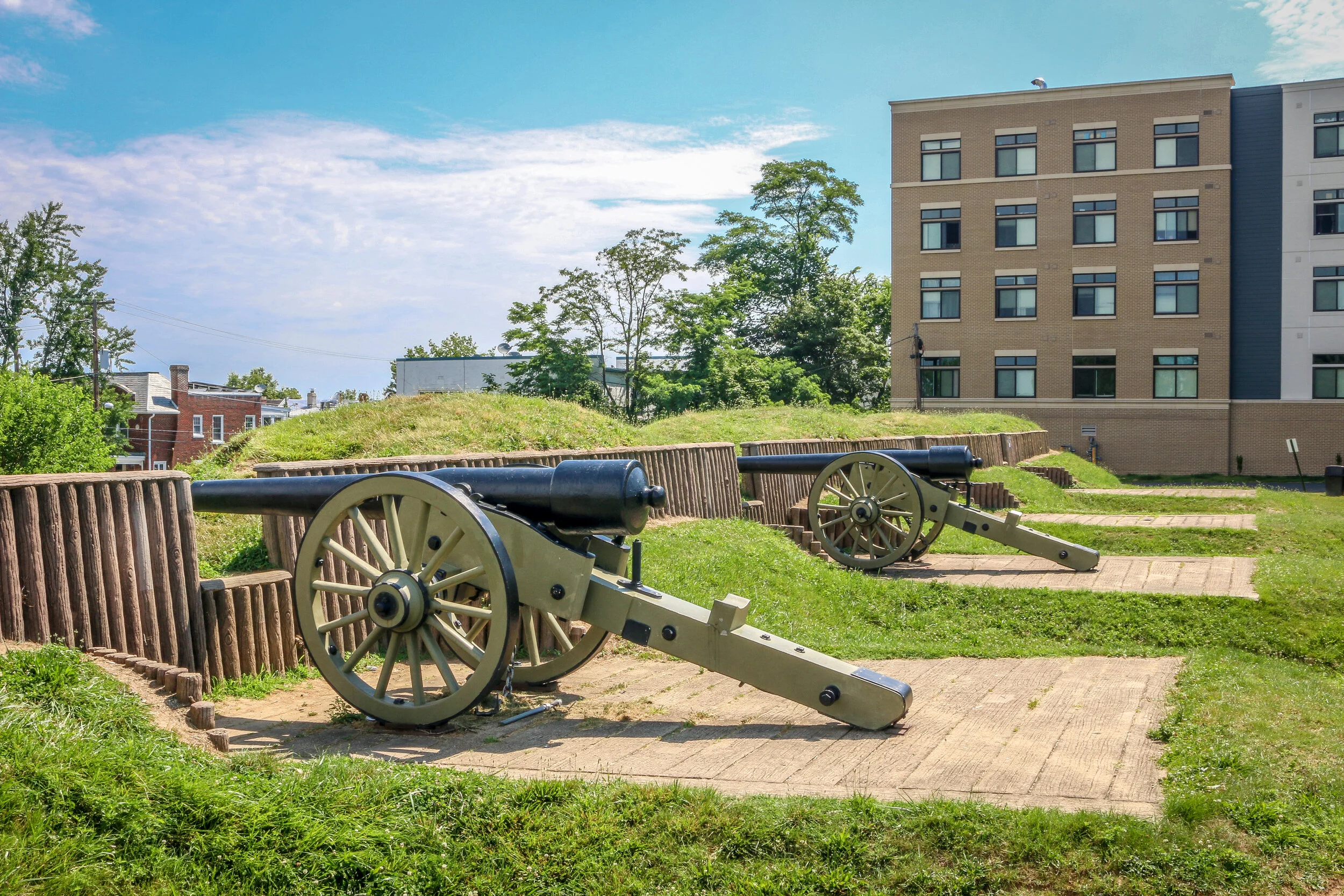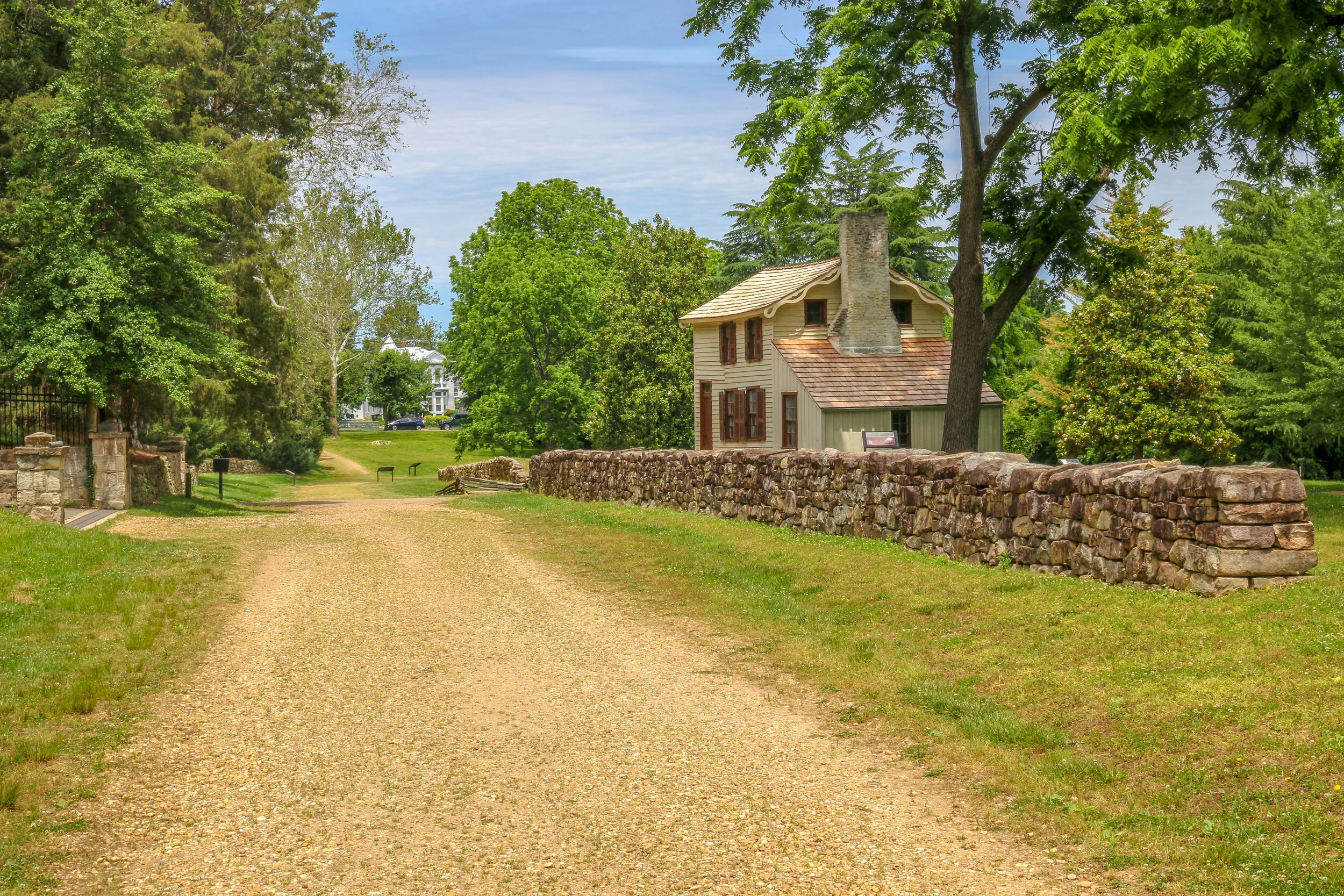This post shares photos and a brief history of the The Old Stone House in Georgetown in Washington D.C.
The Old Stone House was built was built in 1765 on what was then Bridge Street (now M Street) in Georgetown, ten years before the Declaration of Independence and almost 30 years before the founding of Washington D.C. Built of locally quarried stone as a one story structure by a cabinetmaker named Christopher Layman, the building would serve as both his home and shop. After his death later that year, Layman’s widow sold the building to Cassandra Chew who added a rear kitchen in 1767 and a second floor soon thereafter. The third floor was added in the 1790s. Over the next hundred and fifty years, the building would change hands, and uses, many times. By 1953, when the National Park Service purchased the property, it was the site of a local car dealership. The Park Service has since restored much of the Old Stone House to an 18th Century appearance and it is open to the public as part of C & O Canal National Historical Park. It is considered the oldest standing structure in Washington D.C. on it’s original foundation, and is one of very few pre-Revolutionary buildings to be found in the District.
Interestingly, the Park Service points to a mistaken identity as one of the reasons the Old Stone House was preserved. On March 29th, 1791 George Washington was meeting with area landowners to discuss the purchase of land by the federal government to establish the new capital city.
The photos below come from a recent visit to Appomattox Court House National Historical Park near the town of Lynchburg, Virginia. It was the site of the surrender of the Army of Northern Virginia which effectively ended the American Civil War.
After the siege of Petersburg and the fall of the Confederate Capital at Richmond, General Robert E. Lee led his Army of Northern Virginia west with the hopes of turning south to North Carolina and joining with General Joseph Johnson’s army there. They moved towards the train depot at Appomattox Station hoping to find much needed supplies waiting for them there. Union General Phillip Sheridan and his cavalry arrived first, capturing the supply trains and forcing Lee to turn his thoughts towards Lynchburg instead. Surrounded by Union troops, they made one final push at dawn on April 9th, 1865. It didn’t take long to realize that they were surrounded and Lee called for a meeting with Ulysses S. Grant to discuss the terms of surrender.
The site chosen for this conversation was the home of Wilmer McLean in the tiny village of Appomattox Court House. The generals met in the parlor, recreated above, to hammer out the details. The terms offered were very generous as the Confederate soldiers were to be immediately paroled and even allowed to keep their horses and sidearms. Their parole papers were printed in the nearby Clover Hill Tavern. The Southerners marched into town, stacked their rifles, turned over their cannons and marched out. While the surrender of Lee’s Army of Northern Virginia was not the end of the Civil War, there was little chance or hope for the Southern cause in its aftermath. The war would technically drag on until early summer, with skirmishes across the south, but the surrender at Appomattox Courthouse was the beginning of the end. Four long years of fighting which cost over 600,000 lives was finally nearing its conclusion…
I took these photos last week in the midst of the Confederate statue removal process in the old Confederate Capital of Richmond. It was a unique time to visit because some of the statues had already been removed, one of JEB Stuart was in the process of being removed and the two central ones to Robert E. Lee and Jefferson Davis still stood, although both have been slated for removal.
In taking these photos I wanted to capture the spirit of the protests which ultimately have led to the conversation over the removal of these statues, so I have included some close-up shots of the graffiti. Some of the graffiti is targeted towards police brutality while some supports the Black Lives Matter movement.
I am of the opinion that these statues cannot continue to stand in these central places in our nation’s cities. While there are aspects of all of these men which I admire and respect, the cause for which they fought was ultimately the continuation of slavery in perpetuity. There are places for these statues as I believe all art tells a story, but the story currently being told isn’t a complete one and needs to be adjusted with our current understanding of history. These statues coming down isn’t erasing history, it is history.
It’s time. It’s actually long past time for these monuments to come down across the South. When I say these monuments, though, I’m speaking very specifically. I don’t personally believe that all traces of the Confederacy should come down although I don’t believe that doing so would in any way erase history. History is history and no monuments or statues can change it. Many of these monuments, though, were put up not in tribute to fallen soldiers but specifically to support a platform of white supremacy, and that is a history that should be told too. In fact, that is an even more crucial topic for people to learn about if we want to move forward as a nation. But either way, statues to Confederate generals put up in prominent parts of town as hero’s monuments have no place in 2020 America. It’s time for them to come down.
The Civil War was a horrific chapter in our nation’s history which caused the deaths of over 600,000 people. Many of those soldiers’ bodies never came home and are either buried where they fell or among the thousands upon thousands of “unknown” graves around the country. I believe that no matter what their beliefs were, every mother has a right to bury her child and in this case, that wasn’t often possible. Many of the Civil War memorials around the South are depictions of a simple foot-soldier with the names of those soldiers from that town who went to fight in the war. We must also understand that many young men were drafted into the war and did not join of their own free will. Many joined to defend their towns and villages which were most certainly in harm’s way. Many were teenagers who couldn’t have possibly known or understood the larger implications of the war. Most didn’t own slaves. Before I go any further I want to make two things abundantly clear. First, I hate slavery with every bone in my body. I don’t think that owning another person has ever been right in the entire history of the world. Second, I am completely aware that slavery was the primary cause of the Civil War insomuch as had there been no slavery, there would have probably been no war. However the idea that the war began as a noble cause on the part of the abolitionist Northerners to end slavery is simply not true. I wish it was because then I could condemn all Confederates who took up arms and the men who led them. But I know too much about the war to believe that and feel too strongly that too many young men simply got caught up in the war and died too young. So I say let those local memorials stand, but every one of them should be removed from town centers and in front of county courthouses and placed respectfully and with dignity in the local cemeteries. It’s time to bury the dead.
As for these big statues which are coming down now, I know this may be unpopular, but I do respect them as both art and history and I think there is a place for them on the Civil War battlefields of the country. I’d like to see them placed in the hands of the National Park Service which will properly interpret them as to how, why and by whom they were originally erected, who they represent and why they were removed to the battlefield. As for those memorials which were specifically commissioned as a response to Brown vs. The Board of Education or similar hallmarks of progress in Civil Rights, I’d like to see a select few collected to interpret that time in our history and the rest smashed to pieces and used as the foundations to new memorials to the men and women who led that movement.
The photos below come from a recent visit to the battlefields of the greater Richmond/Petersburg Area. With the exception of the first few from Gaines Mill which was important to the Peninsula Campaign of 1862, most of these battles were part of the 1864 Overland Campaign. This long, brutal and bloody series of battles would eventually lead to the capture of Petersburg and the fall of Richmond which set the stage for the surrender of the Army of the Potomac at Appomattox. Civil War Chronicles will trace the major battles of the Eastern Theater of the war through photos and brief histories
Richmond was not the original capital of the Confederacy, but became the capital after Virginia seceded from the Union in April of 1861. Richmond and neighboring Petersburg were major industrial hubs with rail lines connecting to points near and far and the James River to further move supplies in and out of the area. The rivers surrounding the city made defending it somewhat easier as well. Because of the strategic importance of Richmond, it would be the focus of several major campaigns during the war.
Our visit started at Gaines Mill Farm which saw some of the worst fighting of the Seven Days Battle during the Peninsula Campaign of 1862. This battle was the first in which Robert E. Lee had command of the Army of Northern Virginia following the wounding of Joseph Johnston. Lee’s ability to hold off George McClellan and his Union forces would direct the war away from Richmond and back to Northern Virginia to Fredericksburg and Chancellorsville which we visited several weeks ago…
The photos below come from a recent visit to Fort Stevens in Washington D.C. - site of the only battle fought inside D.C. during the Civil War, and of Battleground National Cemetery up the street. The final photo came from Grace Episcopal Church in Silver Spring, MD. Civil War Chronicles will trace the major battles of the Eastern Theater of the war through photos and brief histories.
After overcoming Union General Lew Wallace and his men at the Battle of Monocacy on July 9th, 1864,, Confederate General Jubal Early continued his march towards the Capital of Washington D.C. The Confederate soldiers made the march in two days. Thankfully, Wallace had delayed the Confederates long enough for General Grant to send reinforcements via steamship from Richmond who soon took up position in the northern section of the circle of forts surrounding the city. Fort Stevens guarded the 7th Street Pike, one of the main roads into the city (now Georgia Avenue).
The armies exchanged fire on July 11th and 12th, but Early felt the city was too heavily defended to mount a full scale attack. Both sides lost men in the skirmishing, but casualties were relatively light by Civil War standards. Notably, President Abraham Lincoln came to Fort Stevens on July 12th with his wife, Mary. The two came under fire, the only time in American history that a sitting president was in the direct line of enemy fire. A memorial stone on the parapet marks that location today. That evening, Early would withdraw his men through Maryland and cross the Potomac back into Virginia, marking the end of the final Confederate attack into the North. They paused briefly en-route to bury 17 of their dead comrades at Grace Episcopal Church in Silver Spring…
The photos below come from a recent visit to Monocacy National Battlefield Park just south of Frederick Maryland - site of the “Battle that Saved Washington”. Civil War Chronicles will trace the major battles of the Eastern Theater of the war through photos and brief histories.
The Battle of Monocacy is a bit of an outlier in that it wasn’t really a major battle of the Eastern Theater of the Civil War, but a minor one with major implications. While Generals Grant and Lee were engaged in the final grappling of the war around Petersburg, south of Richmond, Lee wanted a distraction to pull some of Grant’s army away. He attempted this by sending General Jubal Early to go on the offensive and attack into Union territory, the third Confederate invasion of the North during the war. Early was sent with 15,000 men to threaten Washington D.C. and, if possible, to raid the prison camp at Point Lookout and free the Confederate soldiers being held there. Lee also knew that a presidential election was looming and he hoped that another invasion of the North might bring about the defeat of Lincoln and a favorable end to the long and brutal war.
Early’s army crossed the Potomac River into Maryland on the 4th of July, 1864 and marched past Sharpsburg, the site of the Battle of Antietam two years earlier. You can’t march 15,000 infantry troops across a state without anyone noticing, and word quickly got to General Lew Wallace who was then the Union commander in Baltimore. Wallace gathered what men he could muster and quickly set off towards the west. Thinking quickly, Wallace decided to head towards Monocacy Junction, just south of Frederick, Maryland. He didn’t know where the Confederates were headed, but this point would allow his troops to defend the Georgetown Pike to Washington, the National Road to Baltimore and the Baltimore and Ohio Rail Line. If he got there first, he could strategically place his men along the Monocacy River and defend all three of those routes which crossed the river at that point. He arrived in time to dig in and establish a line of defense.
The photos below come from a recent visit to Fredericksburg and Spotsylvania National Battlefield Park, which also includes the Battles of Chancelorsville and The Wilderness. Civil War Chronicles will trace the major battles of the Eastern Theater through photos and brief histories.
It had been almost a year since the horrific battle of Gettysburg, and in the interim President Lincoln had turned command of the Union Army over to General Ulysses S. Grant. Grant would lay out a plan to attack the confederacy on many fronts including Sherman’s march towards Atlanta and an attack on Mobile, and Grant himself would ride with General George Meade’s Army of the Potomac. Their goal was to bring the war back to Virginia and keep the pressure on General Lee and his Army of Northern Virginia. This Overland Campaign would be a war of attrition and would bring the war to new levels of horror but ultimately lead to Lee’s surrender at Appomattox.
On May 4th, 1864 the Army of the Potomac crossed the Rapidan River and engaged Lee’s army in an area called The Wilderness. Apparently the area today bears little resemblance to what it did at the time when new growth underbrush made movement difficult, artillery less effective and confusion the norm. Fierce fighting took place on the scattered farms in the area which allowed for some open space in which to maneuver, but most of the battle took place in the dense forest. On May 6th, the Union Army had taken the upper hand and Lee’s men were in grave danger of being overrun on the widow Tapp’s farm. In a scene from the movies, Longstreet’s reinforcements arrived at just the right moment and Lee was prepared to lead them into battle himself, but the Confederates wouldn’t allow it and moved him quickly to the rear. After two days of heavy fighting neither side had gained a decisive victory. Unlike his predecessors, Grant didn’t pull back but rather pushed forward, ordering a night march towards the town of Spotsylvania Court House. His plan was to get between Lee and the Confederate Capital at Richmond. Sensing this move, Lee ordered his men to move that night as well.
I am not a protester. I don’t like chanting and I don’t want to carry a sign. I am, however, a historian and have spent a big chunk of my life studying U.S. history. I believe strongly in people’s constitutional right to protest and people need to be reminded that that right was not extended to black people in the U.S. until the 14th amendment passed in 1868, a full 80 years after the U.S. Constitution was ratified. That amendment only passed under duress during Reconstruction.
One of my many projects is my podcast American Anthology, and one of my goals with that project has been to call attention to some of the lesser known chapters in the struggle for Civil Rights in this country. We all know about MLK and Rosa Parks, but for a lot of people that’s where things start to fade out. The struggle has been long, painful and bloody beyond belief, and didn’t end with the Civil War or Civil Rights. It has always been just about being treated the same, about having the same rights as white citizens of this country.
My normal goal on this blog is to give people a break from the news and politics with some beautiful photos, but one of the main goals of my podcast has been to help educate people about American History, and especially some of these lesser known chapters. If you want some easily digestible (though not necessarily pleasant or easy to hear) lessons on the struggle and how things have gotten to where we find ourselves today, I’d like to call your attention to some of the topics I’ve covered:
Episode 5 – N.C. – The Wilmington Insurrection – the only successful Coup d’etat in American History
Episode 7 – S.C. – Briggs vs. Elliott – the struggle for a single bus for black students – became part of Brown vs. The Board of Education
Episode 9 – TN - The Lynching of Ell Persons – 5,000 people showed up to this public lynching advertised in the paper. Sandwiches were sold…
It’s been a warm week here in D.C. – summer has definitely arrived. I’ve had some nice days to get out and explore the city this week, but also some hot and humid ones and a few epic thunderstorms as well. It’s been a long time since I’ve experienced summer in our nation’s capital, and there are definitely pluses and minuses. I will say that the lack of traffic anywhere at any time makes the heat of summer a little more tolerable. As I’m sure I’ve mentioned before, that lack of traffic definitely makes for cleaner air and clearer skies – something my camera sees even more than I do. That is one of the plusses of the situation. We’ve been enjoying some summer fruit too, which is one of the best things about summer anywhere. We’ve had beautiful cherries, watermelon, strawberries and others and I’m looking forward to peaches very soon.
Last Friday my stepfather made some wonderful homemade pizzas and we sat in the basement and played some games and listened to some music while we chowed down on a couple of pies. It was another great Forget-About-It Friday, which we are grateful for. This coming week we will tap our homebrew and see how it turned out, and begin our next batch as well – an American Cream Ale. I’m looking forward to having a taste and to keeping the brewing going while I’m home. It’s fun and there’s a (hopefully) fine finished product at the end. After the cream ale, I want to try something a little more complicated now that I’m getting my brewing confidence back up.
The rest of the weekend was pretty quiet. My mom spent Saturday cooking up a storm and we had a wonderful dinner on Saturday night as well. Sunday I spent some time reading my new (to me) book about the Gettysburg Address which I’m really enjoying. I also got some photos edited and published from our trip to Antietam last week, and got some writing done as well. It was a pretty relaxing weekend all around, but it felt good to accomplish a few things along the way.
After being turned back south after the Battle of Antietam, Confederate General Robert E. Lee marched his army back to Virginia. Union General George McClellan was replaced by General Ambrose Burnside to command the Army of the Potomac, and President Lincoln urged Burnside to pursue the Army of Northern Virginia deep into the state and attack the Confederate Capital at Richmond. The major obstacle lying in their way was the Rappahannock River.
Burnside arrived at Stafford Heights overlooking the river and the small town of Fredericksburg in mid-November, 1862. He had sent orders to have pontoons at the ready to provide a means of bringing his army rapidly across the river. Tragically for Burnside and his men, the pontoons didn’t arrive for several weeks. Instead of crossing the river in boats or rafts, he chose to wait for the pontoons. By the time they got there, Confederate troops had dug in on the high ground south of the city called Marye’s Heights and behind a stone wall along a sunken road to the front of this position.
Union engineers worked through the night of December 10th to assemble the pontoon bridge, but their progress was slowed by Mississippi sharpshooters in town. A small group of Union soldiers crossed the river in boats and fought a battle to secure the streets of the town. They finally secured the town in late afternoon on the 11th, but it was winter and the daylight soon gave out. The bridge would be completed and most of the army would cross it on December 12th.
Antietam National Battlefield was the sight of the bloodiest day in American History and one of the best known battle of the American Civil War. Along Antietam Creek just north of the tiny town of Sharpsburg, Maryland, 100,000 soldiers marched into battle on September 17th, 1862. By the end of that day almost 23,000 were dead, wounded or missing.
After a Confederate victory at the 2nd Manassas/Bull Run, General Robert E. Lee pushed into the North for the first time. The Virginia countryside had been ravaged during the first year of the war, and Lee wanted to give it time to heal, plus a decisive victory in the North might bring President Lincoln to the negotiating table.
On September 15th, 1862, Lee crossed the Potomac River into Maryland and dug in along the high ground west of Antietam Creek. Union forces under Commanding General George McClellan moved in from the east. At dawn on September 17th, the battle began…
The photos below come from a cloudy visit to Antietam National Battlefield, the site of the bloodiest day in the American Civil War. Civil War Chronicles will trace the major battles of the Eastern Theater through photos and brief histories.













